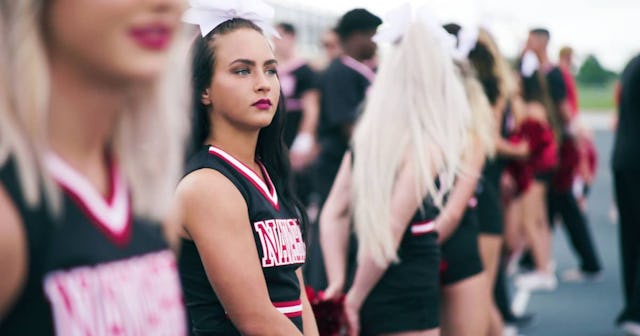New Docuseries 'Cheer' Shows The Dangerous Side Of Competitive Cheer

My partner came home from work excited to turn on the television for me after stumbling upon a docuseries he “just knew” I would love. I was skeptical of his judgment, but then I saw the words on the screen and thought to myself, hmmm, maybe he does listen to me.
Featuring 40 of the best cheerleaders in the nation, and a coach that would make anybody stand up straighter when passing her by, Netflix’s new series Cheer is sure to leave you with cheer-bumps on your arms and adrenaline that won’t stop pumping.
I might sprain my ankle when I walk up the stairs now, but back in my teen years, I was on several competitive cheer teams. Even though I was practicing seven days a week, sometimes attending three different practices for multiple teams a day, it never failed that someone would say to me, “Cheerleading isn’t a sport.”
When cheerleading first originated in the 1960s, the most advanced skill being done was a brief and short jump in the air while pom-poms were waved around. Now, cheerleaders are throwing other people into the air while they kick, flip, and spin before catching them in a cradle.
As seen in Cheer, in the small town of Corsicana, Texas, there’s no doubt that Navarro Cheer has redefined the everyday stereotype of cheerleaders. With their full-fulls, and their basket-fulls, Netflix has given these cheerleaders a platform to prove that there’s more to the sport of cheer than standing on the side of a track in skimpy skirts while shouting, “Goooo team!”
Specifically in competitive cheer, the hours are long, the practices are intense, and the competition is brutal. If a team’s routine isn’t perfected in the two minutes and 15 seconds given during a competition, you can forget winning the very thing you’ve been training a year for.
It takes literal blood, sweat, and tears. In fact, according to the National Center for Catastrophic Sports Injury Research, collegiate cheerleading accounted for 70.5% of all catastrophic injuries, while high school cheerleading rang in at 65.2%. When looking at these high rates injuries, without a doubt, cheerleading tops the cake at being one of the most dangerous sports.
Throughout numerous episodes in Cheer’s first season, Navarro Cheer sees its fair share of injuries in its athletes — both male and female. For a retired cheer-junkie like me, that hit home. I can’t count the number of injuries I (and others) suffered during my time participating in this sport. There’s been long-term, permanent damage done to my body all for the love of a sport that is temporary.
People come from all over the world just for a chance to compete under Navarro’s cheer coach, Monica Aldama, many of them receiving full-ride scholarships at the two-year university for doing so. For those who Aldama coaches, she becomes like a “second mom” to them. She has to be tough on them if they want to win, but on the other hand, her bias against certain members of the team is blatantly obvious.
Not long into the series, a few of the flyers (for those who don’t know, these are the cheerleaders being thrown into the air) are weighing themselves, claiming to be “nervous” about the weigh-ins that Navarro Cheer does — one of them weighing less than 100 pounds. As for the males on the team, it’s been said that Aldama likes her “big boys.” Meaning, she prefers her male athletes to be stout and muscular up top.
This. Is. Not. Okay, and viewers agree.
Truth be told, it reminds me of why I felt the way I did when I was a competitive cheerleader myself. I was small, but I always felt insecure about my body because I wasn’t as small as the flyer I was throwing many feet into the air. I was never weighed during my practices, and my coaches never pressured me about my body, thank God, but the competitive cheerleading world does — and it’s toxic.
Cheerleaders who don’t fit the typical body type are still super talented and fully capable of winning first place. Trust me, I’ve seen it firsthand. And winning aside, doesn’t participation, effort and being a good teammate count for something?
Aldama says that the judges at competition give points based on appearance, and some of her athletes have been given a chance to compete on her championship team because they fit “the look.”
If you haven’t picked up on it, this Netflix series shows the good, the bad, and the ugly that comes with competitive cheer.
With this docuseries being aired, my hope is that others who haven’t been in the “cheer world” can become more enlightened on what it means to be a member of such a strenuous sport. I hope we can open up the conversation surrounding the pros and cons of competitive cheerleading, giving praise where it’s due and correcting the areas where it’s flawed.
Cheerleading is a sport, much like any other, and it’s a brief time in the span of one’s life. You look back on it, and sure, you miss it dearly, but there are so many other things in this life worth living for.
Cheerleaders — please understand, you don’t need to strain your body in every way possible all for the sake of a sport.
This article was originally published on